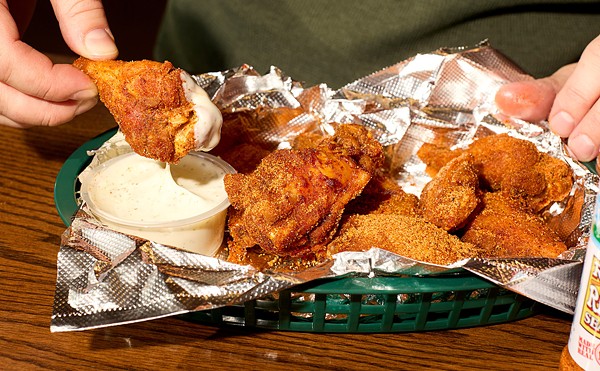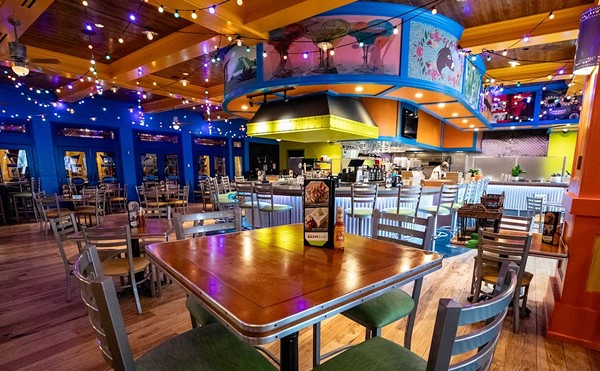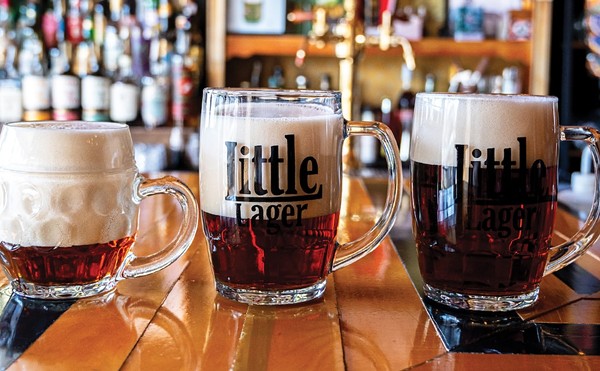When he picked up, however, Kehm was more than happy to talk. I asked him what he thought went wrong with the Spaghetteria's first incarnation in the spring of 2002. "In the beginning we did more, um --" here Kehm pauses, searching for the right term. "American-Italian," he sums up, his tone clearly revealing that even he wasn't pleased with the original concept. Since then, though, Kehm has sold Corky's and eliminated the pinch-fist measures that infuriated diners: Credit cards are now in, and the cheesy ATM that used to be there is out. No more paying by the add-on. The flimsy flatware has been replaced by hefty utensils made to stand up to proper dining, and the wine list and menu -- the latter of which now changes seasonally -- were expanded. To complete the makeover, Kehm brought in a new chef and general manager. All good moves that have helped shed Spaghetteria's bush-league image.
Chef Steve Saffa's menu has gone from the simplistic one-from-Column-A presentation to an approach that's still simple but far more user-friendly. Items offered within the menu categories are priced identically, with fourteen hot and cold antipasti offered at $5 apiece, three salads coming in at $4 each, fifteen pastas going for $10 and entrées for $12. Desserts range from $5 to $7; the only other price variation comes in the form of nightly specials, which span from about $16 to $18.
Fried calamari (offered Tuesday through Thursday only) is a fine place to start. Just about every other restaurant uses squid that's been stripped of the thin, purplish membrane that covers the body. Employing a method he learned while cooking in Sicily, Kehm prefers to retain this layer, lightly dusting the meat in plain flour, then pan-frying it with extra-virgin olive oil for three minutes in a cast-iron skillet. The result is a light, perfect texture and a subtle, smoky flavor -- a marvelous match for a crisp, dry sparkling wine to cut through the olive oil.
In the tradition of Italian cafés, the Spaghetteria displays cold antipasti on a table in the bar area: marinated baby artichokes, grilled asparagus, fava bean salad, heirloom tomatoes and assorted Italian meats and cheeses. Order them from the menu and your server fetches a plateful. As tasty as the asparagus was -- full of grilled flavor and drizzled with a prosciutto vinaigrette -- the five thin spears seemed skimpy at what was essentially a buck a spear. Mussels diavolo, a hot antipasto, are a better value: ten plump black mollusks arrayed in a pool of tomato broth spiced with red pepper flakes and crumbled spicy Italian sausage.
Kehm's keep-it-simple approach extends to the entrée preparations. "My philosophy as a chef is that if you get more than four flavors on a palate, it doesn't pick them up," the owner says. Simplicity, however, doesn't rule out distinctive dishes. Chianti butter and a corn gratin are nice twists to the rib eye steak special, as is a bed of sublime lemon mashed potatoes under an eight-ounce grouper steak. On weekends the Spaghetteria makes fresh pizza (I'm told they can be persuaded to whip one up for you during the week as well). On Friday and Saturday nights, patrons can also watch dough being transformed into fresh pasta while they dine in the newly opened "pasta room," one of the restaurant's three storefront dining areas. On a recent visit the pasta special was a pair of freshly made cannelloni bursting with chunks of lobster, with a smooth creamy tomato sauce ladled on top.
Three salads are available, all dressed with balsamic vinaigrette: a green salad with chopped iceberg lettuce, spinach, red bell pepper, mozzarella and garbanzos (middling); a spinach and arugula salad augmented with orange segments (superb with the tart dressing); and a traditional Roman bread salad with big chunks of day-old Italian bread, basil, roma tomatoes, onions and smoked mozzarella (as close to Rome as it gets around here).
Alhough infrequent, missteps do occur. The otherwise wonderful grouper, dusted with flour and sautéed, emerged pasty and pale rather than golden. The "oven-dried tomatoes" that joined asparagus and artichoke hearts in a very nice creamy pasta dish added nothing but a mushy texture; the distinction between "oven dried" and "cooked in a pan" was nonexistent. Another sad surprise was the lack of good Italian bread, an all-too-common oversight in St. Louis restaurants. While we're at it, the noise level in the middle of the three dining rooms can be overpowering on busy nights, even with the huge café doors thrown open for a view of Tamm Avenue. On less-busy evenings it's quite pleasant, save for the endless loop of Sinatra tunes, which grows tedious. Service is casual but focused. Kehm says he finally has a culinary-oriented staff (a rarity in St. Louis). Courses came out of the kitchen in a timely fashion, and our table's bottle of chilled water -- another honest-to-goodness Italian touch -- was replenished regularly.
Kehm pays homage to Italy -- read about his Italian heritage on the menu or the chalkboard in the bar -- by stocking a decent selection of Italian wines. Given that most casual diners order wine by price, it doesn't hurt that the wine list is organized by number: The list comprises five sections, each of which contains four whites and four reds, with at least one available by the glass. Prices range from $15 per bottle/$4 per glass to $30 per bottle/$8 per glass. For bigger spenders, Kehm also offers a "cellar list" of 22 pricier bottles. There's also a list of specialty drinks (all $6). Italian lemonade, made with Limoncello liqueur and club soda, is refreshing, while a mochatini was more like dessert in a glass: vodka, coffee, chocolate liqueur and cream. Yowzah.
The house-made desserts can be a welcome departure from the run of the mill. The roster of house-made gelati ($5) recently featured both wild-cherry risotto and lemon ice, with the former chock-full of chunky cherries and crunchy rice and the latter a velvet-smooth lemony dream. Fresh strawberries topped with a light cloud of zabaglione ($6) is simple yet elegant. On the heavier side there's strawberry panini ($6), a damn-this-is-good dense chocolate pavé topped with strawberries and a dollop of zabaglione ($6), and mini cannoli (four for $6). An Italian lemon or peach cupcake ($5) may also be available (if you're lucky).
In working to strike that elusive balance between food, cost and ambiance, Kehm has progressed a long way toward his goal of creating an authentic Italian café in Dogtown. He has also succeeded in grasping one simple truth: Learn from your mistakes and move on.





